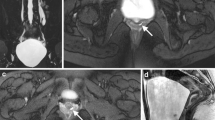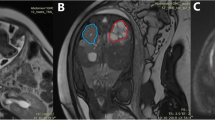Abstract
Congenital abnormalities of the kidney and urinary tract include a wide range of malformations ranging from asymptomatic to life-threatening conditions. Although pediatric urogenital system imaging is based on the use of US (pre- and postnatal), voiding cystourethrography and scintigraphic study, magnetic resonance (MR) urography plays a fundamental role in the classification and management of congenital abnormalities of the kidney and urinary tract, giving an overview of the different clinical pictures, thanks to its panoramicity and high anatomical detail. In fact the anomalies of the urinary tract are phenotypically variable because they can affect simultaneously several segments of different embryonic derivation, with complex clinical pictures; they can appear both as isolated phenotypes or as complex malformative conditions, involving renal parenchyma, collecting system and bladder. A deep knowledge of this complex embryogenesis and its possible phenotypic patterns allows a correct interpretation of MR urography images. We describe the embryology and pathophysiology of congenital abnormalities of the kidney and urinary tract as well as MR urography technique and findings. Congenital abnormalities of the kidney and urinary tract are classified into four groups: (1) obstruction (proximal, middle and distal), (2) budding with respect to the Wolffian duct (site and number of ureter), (3) ascent and rotation (ectopia, malrotation and fusion of kidney) and (4) anomaly of metanephric differentiation (dysplasia, megapolicalycosis).




















Similar content being viewed by others
References
Guay-Woodford LM (2011) Hereditary nephropathies and developmental abnormalities of the urinary tract. In: Goldman L, Schafer AI (eds) Goldaman’s cecil medicine, 24th edn. Elsevier, Philadelphia, pp 800–805
Dickerson EC, Dillman JR, Smith EA et al (2015) Pediatric MR urography: indications, techniques, and approach to review. Radiographics 35:1208–1230
Surabhi VR, Menias CO, George V et al (2015) MDCT and MR urogram spectrum of congenital anomalies of the kidney and urinary tract diagnosed in adulthood. AJR Am J Roentgenol 205:W294–W304
Toka HR, Toka O, Hariri A et al (2010) Congenital anomalies of kidney and urinary tract. Semin Nephrol 30:374–386
Berrocal T, López-Pereira P, Arjonilla A et al (2002) Anomalies of the distal ureter, bladder, and urethra in children: embryologic, radiologic, and pathologic features. Radiographics 22:1139–1164
Türkvatan A, Olçer T, Cumhur T (2009) Multidetector CT urography of renal fusion anomalies. Diagn Interv Radiol 15:127–134
Jain S, Chen F (2018) Developmental pathology of congenital kidney and urinary tract anomalies. Clin Kidney J 12:382–399
Riccabona M, Avni FE, Dacher J et al (2010) ESPR uroradiology task force and ESUR paediatric working group: imaging and procedural recommendations in paediatric uroradiology, part III. Minutes of the ESPR uroradiology task force minisymposium on intravenous urography, uro-CT and MR-urography in childhood. Pediatr Radiol 40:1315–1320
Antonov NK, Ruzal-Shapiro CB, Morel KD et al (2016) Feed and wrap MRI technique in infants. Clin Pediatr 56:1095–1103
Vivier PH, Dolores M, Taylor M et al (2010) MR urography in children. Part 1: how we do the F0 technique. Pediatr Radiol 40:732–738
Parikh KR, Hammer MR, Kraft KH et al (2015) Pediatric ureteropelvic junction obstruction: can magnetic resonance urography identify crossing vessels? Pediatr Radiol 45:1788–1795
Mitsumori A, Yasui K, Akaki S et al (2000) Evaluation of crossing vessels in patients with ureteropelvic junction obstruction by means of helical CT. Radiographics 20:1383–1395
Yiee JH, Johnson-Welch S, Baker LA et al (2010) Histologic differences between extrinsic and intrinsic ureteropelvic junction obstruction. Urology 76:181–184
Krajewski W, Wojciechowska J, Dembowski J et al (2017) Hydronephrosis in the course of ureteropelvic junction obstruction: an underestimated problem? Current opinions on the pathogenesis, diagnosis and treatment. Adv Clin Exp Med 26:857–864
Docimo SG, Lebowitz RL, Retik AB et al (1989) Congenital midureteral obstruction. Urol Radiol 11:156–160
Farrugia MK, Hitchcock R, Radford A et al (2014) British Association of Paediatric Urologists consensus statement on the management of the primary obstructive megaureter. J Pediatr Urol 10:26–33
Shokeir AA, Nijman RJ (2000) Primary megaureter: current trends in diagnosis and treatment. BJU Int 86:861–868
Tokunaka S, Gotoh T, Koyanagi T et al (1984) Muscle dysplasia in megaureters. J Urol 131:383–390
Berdon WE, Baker DH, Becker JA (1968) Ectopic ureterocele. Radiol Clin N Am 6:205–214
Bisset GS 3rd, Strife JL (1987) The duplex collecting system in girls with urinary tract infection: prevalence and significance. AJR Am J Roentgenol 148:497–500
Nordmark B (1948) Double formations of the pelves of the kidneys and the ureters. Embryology, occurrence and clinical significance. Acta Radiol 30:4–5, 267–278
Tam T, Pauls RN (2021) Embryology of the urogenital tract; a practical overview for urogynecologic surgeons. Int Urogynecol J 32:239–247
Valerius MT, Patterson LT, Witte DP et al (2002) Microarray analysis of novel cell lines representing two stages of metanephric mesenchyme differentiation. Mech Dev 110:151–164
Saxén L, Sariola H (1987) Early organogenesis of the kidney. Pediatr Nephrol 1:385–392
Fernbach SK, Feinstein KA, Spencer K et al (1997) Ureteral duplication and its complications. Radiographics 17:109–127
Adeb M, Darge K, Dillman JR et al (2013) Magnetic resonance urography in evaluation of duplicated renal collecting systems. Magn Reson Imaging Clin N Am 21:717–730
Inamoto K, Tanaka S, Takemura K et al (1983) Duplication of the renal pelvis and ureter: associated anomalies and pathological conditions. Radiat Med 1:55–64
Carrico C, Lebowitz RL (1998) Incontinence due to an infrasphincteric ectopic ureter: why the delay in diagnosis and what the radiologist can do about it. Pediatr Radiol 28:942–949
Privett JT, Jeans WD, Roylance J (1976) The incidence and importance of renal duplication. Clin Radiol 27:521–530
Ibrahimi A, Hosni A, Ziani I et al (2020) Zinner’s syndrome: a rare diagnosis of dysuria based on imaging. Case Rep Urol 2020:8826664
Livingston L, Larsen CR (2000) Seminal vesicle cyst with ipsilateral renal agenesis. AJR Am J Roentgenol 175:177–180
Levisay GL, Holder J, Weigel JW (1975) Ureteral ectopia associated with seminal vesicle cyst and ipsilateral renal agenesis. Radiology 114:575–576
Sheih CP, Hung CS, Wei CF, Lin CY (1990) Cystic dilatations within the pelvis in patients with ipsilateral renal agenesis or dysplasia. J Urol 144:324–327
Van den Ouden D, Blom JH, Bangma C et al (1998) Diagnosis and management of seminal vesicle cysts associated with ipsilateral renal agenesis: a pooled analysis of 52 cases. Eur Urol 33:433–440
Barakat AJ, Drougas JG (1991) Occurrence of congenital abnormalities of kidney and urinary tract in 13,775 autopsies. Urology 38:347–350
Rinat C, Farkas A, Frishberg Y (2001) Familial inheritance of crossed fused renal ectopia. Pediatr Nephrol 16:269–270
O’Brien J, Buckley O, Doody O et al (2008) Imaging of horseshoe kidneys and their complications. J Med Imaging Radiat Oncol 52:216–226
Winyard P, Chitty LS (2008) Dysplastic kidneys. Semin Fetal Neonatal Med 13:142–151
Clark AT, Bertram JF (1999) Molecular regulation of nephron endowment. Am J Physiol 276:F485–F497
Grattan-Smith JD, Little SB, Jones RA (2008) Evaluation of reflux nephropathy, pyelonephritis and renal dysplasia. Pediatr Radiol 38:S83–S105
Bekele W, Sanchez TR (2010) Congenital megacalyces presenting as neonatal hydronephrosis. Pediatr Radiol 40:1579
Acknowledgements
Our sincere thanks to Valentina Sanclemente (Velenia) for the original and exclusive drawings.
Author information
Authors and Affiliations
Corresponding author
Ethics declarations
Conflicts of interest
None
Additional information
Publisher’s note
Springer Nature remains neutral with regard to jurisdictional claims in published maps and institutional affiliations.
Rights and permissions
About this article
Cite this article
Campo, I., Sertorio, F., Wong, M. et al. Magnetic resonance urography of congenital abnormalities — what the radiologist needs to know. Pediatr Radiol 52, 985–997 (2022). https://doi.org/10.1007/s00247-021-05233-2
Received:
Revised:
Accepted:
Published:
Issue Date:
DOI: https://doi.org/10.1007/s00247-021-05233-2




